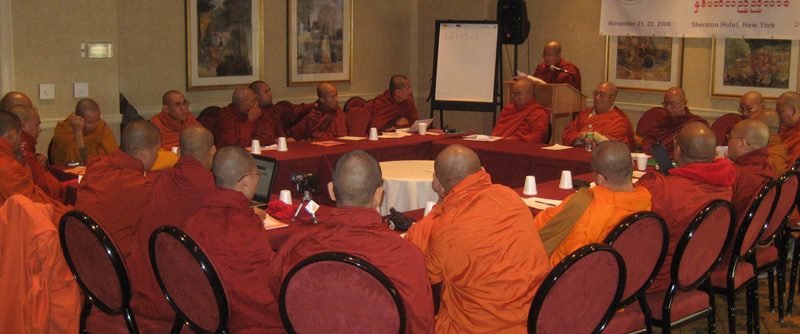Outside their dingy brick building, nine Burmese monks huddled around the latest underground update from their brother monks back in Burma. Four hundred monks unaccounted for, the fax said. Two hundred more in prison.
Since the failure of the September 2007 uprising in Burma they helped lead, New York City has become a central place of refuge for Burmese monk-activists, many on the run for their lives.
This office-cum-monastery in Elmhurst, Queens, has been fashioned into the unlikely international headquarters of the monks’ resistance movement. It’s a nexus of prayer, to embody dharma, the Buddha’s tradition of loving kindness and compassion; solace and refuge for displaced monks; and a center of international advocacy for political and social freedom in Burma. The country, renamed Myanmar by its military rulers, has been controlled by military governments since 1962, when a coup toppled the civilian government. None of the periodic protests to demand opening and democracy has had much success.
The monks in America quietly considered the latest report. Their bodies were wrapped in red-orange robes of different shades, twisting from front to back, starting at their ankles and finishing over their left shoulders. At home, traditional Burmese monastic life has been nearly obliterated, they told me. Whether or not they’d ever been in jail, monks in Burma are now afraid to wear their robes. The government has managed to strip away their identities.
“Only here can we keep our traditions alive,” said Ashin Nayaka, a visiting religion professor at Columbia University who was serving as the group’s translator.
The Elmhurst monks are an elite group. The spiritual director, Venerable U Pannya Vamsa, 83, is Burma’s leading expatriate monk dissident. He came to the United States 30 years ago, and built this country’s first Burmese Buddhist temple, in Los Angeles. Opposite him was former political prisoner U Aggadhamma, who survived five years of daily torture. U Kovida – away in California to promote democracy for Burma — was a leader of the September 2007 uprising, the so-called Saffron Revolution.
At 26, U Kovida, from the rice growing land of both Buddhism and Islam, on Burma’s western coast bordering Bangladesh, is youngest of this group of refugee monks, and also considered the most “liberal.” He became a monk at age 12. In 2007, when skyrocketing fuel prices sparked protests, and democracy activists, monks and ordinary people began to take to streets to protest decades of repressive rule, the authorities raided Kovida’s monastery. So Kovida set off for Yangon, the former capital, to join the demonstrations.
“I don’t like to just pray,” he said. “Because it won’t do anything. If you want to be free, breathe, you have to fight.”
In Yangon, 2,000 protesters and 500 monks sat on the tiled floor of 152 foot-high golden domed Sule Pagoda. U Kovida called on 10 fellow monks to help him lead a march, and 15 came forward. They led columns of demonstrators down the streets.
Their leadership was soon felt: around the city, other groups of monks began to organize marches. Led by as many as 50,000 monks, the demonstrators grew to some 150,000 in number, Human Rights Watch reported at the time.
The government soon began a violent crackdown. “The police pulled off the monks’ robes and beat them,” U Kovida remembered.

